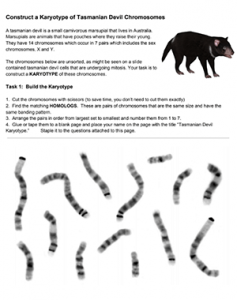
This activity was created as an alternative to “A Chromosome Study” where students use a paper model of human chromosomes to cut and paste 23 pairs in order and diagnose a disorder like Down Syndrome. Unfortunately, this activity is time consuming.
I still want students to visually explore how karyotypes are used. I still want them to visualize homologous chromosomes. I want them to understand that the diploid number of a chromosome is based on matching sets. Photographs usually don’t engage the students like a hands-on activity.
So I created this activity that explores Tasmanian devil chromosomes. It is simpler because those animals only have 14 chromosomes. Much easier to cut and paste!
. The image is loosely based on an image from Nature showing chromosomes of Tasmanian devils with facial tumor disease. I redesigned the chromosomes in Photoshop, but they are not actual images of devil chromosomes.
Student Activity
Students cut out each chromosome and organize them in pairs based on their patterns and size. Then they number them to determine the diploid number for the species. Finally, they consider a situation where the animal has an extra chromosome. Students must determine which set has the extra chromosome and consider the concept of trisomy.
Time Required: 35-45 minutes
Grade Level: 9-12
You can also extend this lesson to include discussions about cancer and conservation. The species is now endangered due to a contagious form of cancer that causes facial tumors. This video can be used to introduce students to the organism they are studying:
HS-LS3-1 Ask questions to clarify relationships about the role of DNA and chromosomes in coding the instructions for characteristic traits passed from parents to offspring.
HS-LS3-2 Make and defend a claim based on evidence that inheritable genetic variations may result from: (1) new genetic combinations through meiosis, (2) viable errors occurring during replication, and/or (3) mutations caused by environmental factors.

